





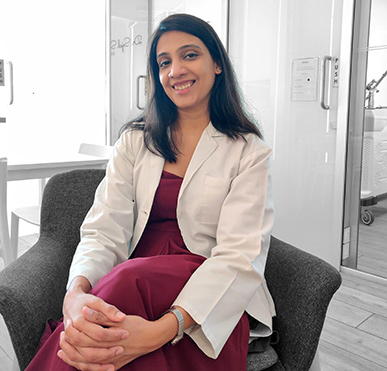
InUrSkn is more than just a skin a hair and body clinic. It is Dr. Sejal's promise of providing minimal intervention patient care which is holistic, personalized and humane.













Neonatal Skin (newborn baby’s skin) is similar in structure to adult skin but is not as functional. Hence it requires special attention. Neonatal skin conditions are disorders occurring in newborns’ skin, often resulting from delicate skin reacting to environmental or internal factors. Most of these conditions are harmless and resolve independently, though medical evaluation is advisable for persistent or severe cases.
Read More
Most women undergo substantial change to their skin during pregnancy and postpartum. These changes are largely due to changes in physiology which are hormonal, immunological, metabolic and vascular in nature and may require the attention of an experienced dermatologist.
Read More
Children are often more susceptible to infections because of their lower immunity, lower hygiene levels and highly active lifestyle.
Infectious Skin and Hair Conditions in children are similar as in adults but may take a different manifestation.

Non Infectious conditions in children like in adults can be related to change in hormones, change in immunity levels etc. Also some conditions in children can be genetic.
Read More
Ageing results in decline of normal functioning in all organ systems including skin. Two types of skin ageing exist. These are intrinsic ageing, which includes those changes that are due to normal maturity and occur in all individuals and extrinsic ageing, produced by extrinsic factors such as ultraviolet light exposure, smoking, and environmental pollutants.
Read More

When the health problem is related to a specific part or organ of the body like skin, approaching a specialist substantially reduces the time taken from identification to the start of treatment, which often can be quite critical. MD or DNB specialists like dermatologists undergo intense training and education for 3 more years studying dermatology and venereology after they have passed their MBBS exam. During this period they work with senior specialists and help with treatment of thousands of patients suffering from a variety of conditions. This gives them the ability to quickly diagnose ailments and treat them far more effectively than a general physician can.
This learning does not end at qualifying as an MD, it is actually a continuous process where they participate in conferences and clinical meets to discuss and understand the latest developments in their field. This benefits the patients substantially as they are able to prescribe the latest and most effective line of treatments.
Dermatologists see hundreds of patients on a daily basis with a variety of conditions ranging from simple skin and cosmetic conditions to very rare and complex skin conditions making it a lot easier and quicker for dermatologists to diagnose and treat such conditions.
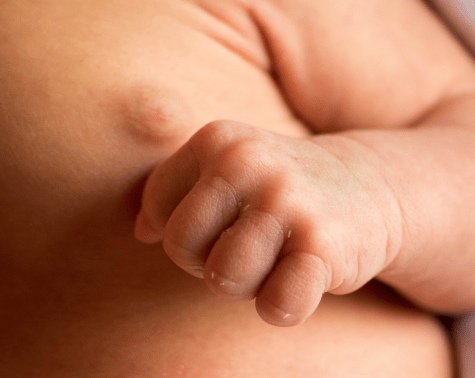
Neonatal Skin (newborn baby’s skin) is similar in structure to adult skin but is not as functional. A newborn’s skin as compared to an adult’s skin has a very thin upper layer. Also a baby’s skin is more porous. The water retention mechanism and the melanin in the skin are also not fully developed.
There are certain conditions that occur in neonates but persist for a very short period. Some of the common ones are:
Milia: These are small pinpoint whitish boils.
Acne: Pimples which appear due to circulating maternal hormones.
Mongolian Spots: These are greenish patch on the lower back, buttocks or shoulders.
Flat Hemangioma: these are Pinkish / Reddish patches on forehead or back of the neck.
Peeling of Skin: It is commonly seen on palms and soles.
Suction Blister: It is blisters on fingers, due to sucking action in the uterus.
Cradle Cap: It is a thick scaly greasy patches on the scalp.
Some of the common persistent conditions that occur in newborn babies are:
Diaper Rash : These are seen as itchy red rashes in the groin, buttocks or pubic area. It is mainly caused because of friction or prolonged contact with urine or faeces.
Bacterial Infection : This is seen as pus filled boils, on face, neck or abdomen and are contagious in nature.
Fungal Infection : It presents as white creamy patches in the mouth.
Atopic Dermatitis : This condition presents as Itchy red rashes on the face, neck, folds of the body.
1. Use a thick moisturizing lotion at least twice a day.
2. Avoid using oil and giving oil massages on a baby’s skin
3. The worst enemy of dry skin is powder.
4. Make sure that the baby does not remain in a wet diaper for long.
5. Avoid any ‘organic’ skin care products and home remedies on babies.
6. Use cotton clothes and ensure that you cut away any labels on the inside of clothes so that it does not cause constant irritation leading to eczema.
7. The melanin levels in a baby’s skin is also low and hence it is extremely important to protect them from UV rays.
8. Long baths and showers for a baby are something you should avoid at all costs. These tend to speed up the drying of the baby’s skin.
To prevent diaper rash, you should change your baby’s diaper frequently and use a diaper cream or ointment. Avoid using wipes or products that contain alcohol or fragrances.
Cradle cap is a common condition in newborns where the scalp becomes dry and flaky. It typically resolves on its own, but you can help by washing your baby’s scalp with a mild shampoo and gently brushing their hair.
Yes, newborns can get acne, which typically appears on the face and clears up on its own within a few weeks or months.
If your newborn has eczema, you should consult your healthcare provider for guidance. They may recommend using a mild soap, moisturizer, or prescription medication to manage the symptoms.
Dry skin in newborns is caused by the natural shedding of the outermost layer of skin. To treat it, you can use a gentle moisturizer and avoid over-bathing your baby.
Yes, newborns can get sunburned, so it’s important to keep them out of direct sunlight and to dress them in protective clothing.
A strawberry hemangioma is a type of birthmark that appears as a bright red or purple bump on the skin. It is not dangerous and usually goes away on its own within a few years.
To prevent diaper rash, you should change your baby’s diaper frequently, use a diaper cream or ointment, and avoid using wipes or products that contain alcohol or fragrances.
Newborns can develop warts, which are caused by a viral infection. However, they are not common in newborns and usually go away on their own.
If you suspect that your newborn has a skin infection, you should contact your healthcare provider for guidance. They may prescribe an antibiotic or recommend other treatments.
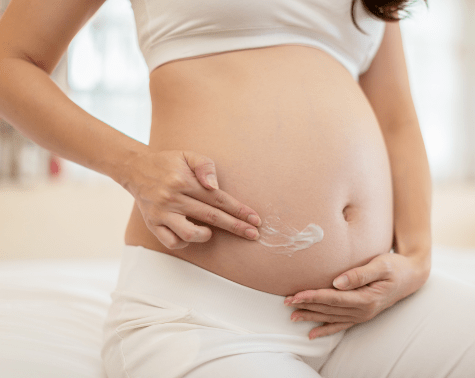
Most women undergo substantial change to their skin during pregnancy and postpartum. These changes are largely due to changes in physiology which are hormonal, immunological, metabolic and vascular in nature.
Skin conditions related to pregnancy can be categorized into those conditions which are aggravated due to pregnancy and those which are caused by pregnancy. Some of these conditions are as listed below.
Existing pigmented areas become more pronounced.
Melasma is often seen. It is called the mask of gestation.
The increase in hormones leads to more acne.
Varicose Veins or Spider Veins are seen due to increased blood circulation.
Stretch Marks are seen in the abdomen/stomach due to stretching of the skin.
A generalized dryness of the skin occurs due to hormonal changes.
Existing skin conditions like eczema tend to flare up.
There is an increased hair growth because of change in hormones.
During gestation, various conditions may present on the skin as mentioned below:
– Itchy red rashes on abdomen and extremities in second trimester.
– Blisters are seen on abdomen and extremities in the second half of gestation.
– Itchy dry patches on any part of the body.
– Generalized itching in second half of gestation due to jaundice magna.
Hormonal fluctuations during pregnancy can lead to various skin changes. Increased hormones can stimulate oil glands, leading to acne, and can also cause hyperpigmentation, and stretching skin can lead to stretch marks.
Stretch marks are streaks or stripes on the skin, usually on the abdomen, hips, thighs, and breasts. They occur when the skin stretches rapidly. While they cannot be completely prevented, keeping the skin moisturized can minimize their appearance.
Melasma, also known as the “mask of pregnancy,” is caused by an increase in melanin production due to hormonal changes. It often fades post-pregnancy, but sunscreen can help prevent worsening.
Yes, hormonal changes can lead to increased oil production, causing acne. It’s essential to follow a gentle skincare routine and consult with a dermatologist before using acne treatments during pregnancy.
Hair loss can occur after delivery due to a drop in hormones. This condition, known as telogen effluvium, is usually temporary.
Many women experience hair thickening due to increased estrogen which prolongs the growing phase of hair. This is usually temporary, reverting post-pregnancy.
There is very little research to establish if any harmful effects can be expected from the limited absorption of hair dye percutaneously through the scalp. However in order to reduce the slightest chance of any adverse effects, it is best to avoid it till second trimester or even altogether.
Some ingredients in skincare products may not be recommended during pregnancy. It’s best to consult with a healthcare provider or dermatologist to ensure your skincare regimen is safe.
Itching can be caused by stretched skin or underlying conditions like cholestasis of pregnancy. Persistent itching should be evaluated by your dermatologist.
Varicose veins, enlarged veins often appearing on legs, can be managed by avoiding long periods of standing, elevating your legs, and wearing compression stockings.
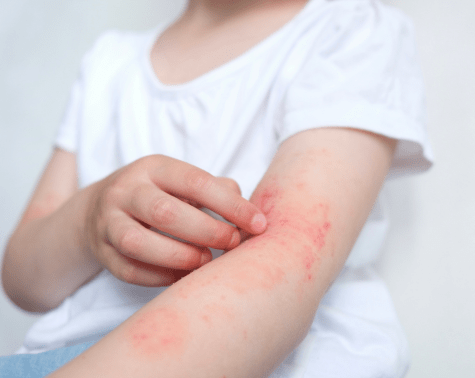
Children are often more susceptible to infections because of their lower immunity, lower hygiene levels and highly active lifestyle.
Infectious Skin and Hair Conditions in children are similar as in adults but may take a different manifestation. Also these conditions like adults are caused either by fungus, virus, bacteria or parasite.
1. Ring worms are very common in children. They are commonly seen on scalp, groin and body. It presents as itchy red scaly patches in the above areas.
2. Other fungal infections like pityriasis versicolor (white or brown patches on chest and back) are also common.
These are very common in children. Low immunity in children makes them more vulnerable due to its contagious nature.
1. Chicken Pox: It is seen as multiple itchy small blisters on face, chest, back etc.
2. Warts: These are tiny growths seen on hands, feet and face.
3. Molluscum Contagiosum: These are all white boils seen on face, hands and chest.
4. Pityriasis Rosea: These are seen as itchy red rashes present on the back, chest and hands.
5. Herpes Simplex: This presents as tiny painful grouped blisters commonly seen on lips.
1. Impetigo: It is seen as brownish, crusted painful lesions on the face, legs and hands.
2. Boils: Seen as painful, red bumps which can occur on any part of the body.
1. Pediculosis Capitis – Commonly called Lice – This is probably the most common hair related condition in children. It is seen more in girls due to long hair. This condition presents as itchy scalp studded with nits (eggs) and lice.
2. Fungal infections – Seen as itchy ring like patches on the scalp associated with loss of hair in that area. It can also present as boggy swelling on the scalp. It is also associated with hair loss.
3. Bacterial infections – It presents on the scalp as small painful red bumps.
Ringworm is treated with antifungal creams or, in severe cases, oral antifungal medications to inhibit the growth of the fungus.
Treatment of Pityriasis Versicolor involves topical or oral antifungal medications to inhibit fungal growth and normalize skin pigmentation.
Chickenpox is managed with antiviral medications, itch-relieving lotions, and over-the-counter medications to alleviate symptoms, with vaccination as a preventive measure.
Treatment may include topical acids, cryotherapy (freezing), or minor surgical procedures to remove the warts.
Treatments may include topical medications, cryotherapy, or minor surgical removal to eliminate the lesions and prevent spread.
Treatment may include topical steroids and antihistamines to manage itching and inflammation, although the condition often resolves on its own.
Antiviral medications are used to manage herpes simplex outbreaks, reduce symptoms, and decrease transmission risk.
Impetigo is treated with topical or oral antibiotics to eliminate the bacterial infection.
Treatment may include warm compresses to promote drainage, and in some cases, surgical drainage and antibiotic therapy to clear the infection.
Treatment includes medicated shampoos to kill the lice, along with thorough cleaning of personal items and environment to prevent re-infestation.
Treatment typically involves oral antifungal medications and medicated shampoos to eliminate the fungal infection and prevent further hair loss.
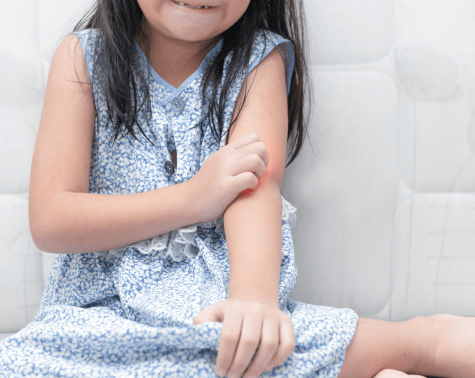
Non Infectious conditions in children like in adults can be related to change in hormones, change in immunity levels etc. Also some conditions in children can be genetic. It is interesting to note that a lot of conditions in children may be transient and may automatically reduce as they grow up.
Atopic Eczema: It presents as itchy red rashes seen commonly on face, folds of the body. It can start during newborn period or later and continue till 12- 14 years. Rashes flare up during winters. Sometimes seen in association with recurrent cold and cough.
Allergic Reactions: Reaction to an insect bite is quite common in children as their immune responses are still developing. These are seen as small, itchy, red bumps commonly seen on exposed areas of the body, legs, hands and face.
Prepubertal Acne: Acne can be seen in children between 8-10 years due to a surge in hormones before the onset of puberty.
Seborrheic Dermatitis:Commonly known as dandruff. It is seen as dry itchy white flakes on the scalp. Sometimes the flakes are thick and adherent.
Alopecia Areata: Seen as small patches on the scalp which are devoid of hair. It is an autoimmune condition and can be seen in association with thyroid disorders, diabetes etc.
Hair loss: In children hair fall can occur due to various causes like high fever, prolonged infection, surgery, nutritional deficiencies, poor eating habits to name a few.
Trichotillomania: It is a type of hair loss caused by the child pulling or plucking his / her hair. The hair loss is patchy and characterized by broken hairs of varying length. Patches are typically seen on the side of the child’s dominant hand.
Treatment often includes moisturizing creams to maintain skin hydration, topical steroids to reduce inflammation, and antihistamines to alleviate itching, under the guidance of a dermatologist.
Treatment usually involves cleaning the area, applying topical anti-itch creams or antihistamines to alleviate itching, and in severe cases, a dermatologist may prescribe oral antihistamines or steroids.
Treatment for prepubertal acne may include gentle cleansing of the affected area, topical benzoyl peroxide or salicylic acid, and in some cases, topical or oral antibiotics prescribed by a dermatologist.
Treatment typically includes using medicated shampoos containing selenium sulfide or zinc pyrithione, and in severe cases, a dermatologist might prescribe topical antifungals or steroids to alleviate symptoms.
Treatment might involve corticosteroid creams or injections to stimulate hair growth, although it’s crucial to consult with a dermatologist for a personalized treatment plan, especially given its association with other autoimmune conditions.
Treatment depends on the underlying cause; it may include addressing nutritional deficiencies through a balanced diet or supplements, or treating underlying medical conditions, always under the supervision of a dermatologist.
Treatment usually involves behavioral therapy to address the hair-pulling behavior, and in some cases, a dermatologist may work in conjunction with a psychologist or psychiatrist to provide a comprehensive treatment approach.
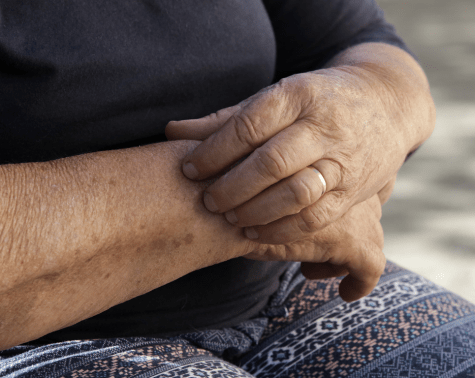
Ageing results in decline of normal functioning in all organ systems including skin. Two types of skin ageing exist. These are intrinsic ageing, which includes those changes that are due to normal maturity and occur in all individuals and extrinsic ageing, produced by extrinsic factors such as ultraviolet light exposure, smoking, and environmental pollutants. Ageing also causes changes at cellular level. There is a decline in collagen and elastin which causes, wrinkles and loose skin. There is decrease in sweat and oil glands activity also.
Roughened or Dry Skin: Due to loss of moisture, skin becomes extremely dry and cracked leading to xerotic eczema.
Prevention: Keep the skin moisturized by applying hydrating creams or lotions regularly, especially after bathing.
Treatment: For severe cases, a dermatologist might prescribe topical steroids or other medicated creams to manage symptoms.
Benign Growths such as seborrheic keratosis, cherry angiomas, skin tags etc. These harmless growths are associated with ageing.
Prevention: Regular skin examinations can help monitor and identify any new or changing growths early.
Treatment: Although typically not necessary, treatment options such as cryotherapy, electrocautery, or excision can be explored with a dermatologist if removal is desired.
Age Spots: These are small brown spots on sun exposed areas.
Prevention: Regular use of broad-spectrum sunscreen can help prevent or minimize the appearance of age spots.
Treatment: Treatments such as laser therapy, cryotherapy, or topical bleaching agents can be used to fade age spots, under the guidance of a dermatologist.
Loose Facial Skin, especially around the eyes, cheeks, and jowls (jawline). Due to reduction in collagen and elastin, there is a loss of elasticity giving rise to above changes.
Prevention: Protecting skin from the sun by using sunscreen, wearing protective clothing, and avoiding smoking can help maintain skin’s elasticity.
Treatment: Treatments like laser resurfacing, dermal fillers, or radiofrequency therapy can help tighten loose skin, under the supervision of a dermatologist.
Transparent or Thinned Skin leading to easy bruising: Due to decreased elastin and skin thickness skin gets bruised easily.
Prevention: Avoiding excessive sun exposure and using protective measures like wearing long sleeves can help prevent further thinning of the skin.
Treatment: While thinning skin is a natural Ageing process, addressing any contributing factors like poor nutrition or steroid use with the help of a dermatologist can be beneficial.
Increased susceptibility to infections (due to low immunity): Fungal and bacterial infections are commonly seen. Also, bedsores are common in bedridden patients.
Prevention: Maintaining good hygiene, keeping skin dry, and turning bedridden patients frequently to prevent bedsores are crucial preventive measures.
Treatment: Infections may be treated with topical or oral antibiotics or antifungals, and bedsores may require specialized wound care under a healthcare provider’s supervision.
Skin Cancer: Certain types of skin cancer are seen with ageing.
Prevention: Regular use of broad-spectrum sunscreen, avoiding tanning beds, and undergoing routine skin checks can help in early detection and prevention of skin cancer.
Treatment: Treatment options can range from surgical removal, chemotherapy, radiation therapy, to immunotherapy, depending on the type and stage of skin cancer, under the guidance of an oncologist or dermatologist.
Skin care is important for older adults because as we age, our skin becomes thinner, drier, and more fragile. This can increase the risk of skin damage, infections, and other skin problems.
Common skin concerns in older adults include dry skin, wrinkles, age spots, skin cancer, and infections.
To prevent skin damage as you age, you should protect your skin from the sun, avoid smoking, eat a healthy diet, stay hydrated, and use gentle skin care products.
To keep your skin hydrated, you should drink plenty of water, use a moisturizer regularly, avoid hot showers or baths, and use a humidifier in your home.
As you age, it’s a good idea to see a dermatologist regularly, especially if you have a history of skin problems or a family history of skin cancer. Your healthcare provider can recommend how often you should be seen based on your individual needs.
As you age, you should look for skin care products that contain ingredients like retinol, hyaluronic acid, and antioxidants, which can help to reduce the signs of Ageing and keep your skin healthy.
Yes, certain medications can affect your skin as you age. Some medications can cause dry skin, rashes, or other skin problems. It’s important to discuss any concerns with your healthcare provider.
To protect your skin from the sun as you age, you should wear protective clothing, use sunscreen with an SPF of at least 30, and avoid spending time in the sun during peak hours.
To prevent infections in your skin as you age, you should keep your skin clean and dry, avoid scratching or picking at your skin, and avoid contact with others who have skin infections.
You should see a dermatologist if you notice any changes in your skin, such as new moles or growths, changes in the color or texture of your skin, or persistent itching or rashes. A dermatologist can help to diagnose and treat any skin problems you may have.

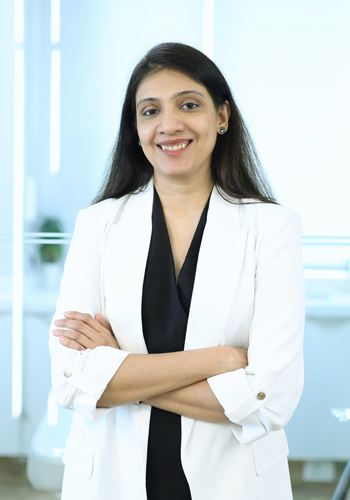
MD, DNB - Dermatology & Venereology
Dr. Sejal has dual degrees of MD and DNB in Dermatology and Venereology. She has worked with some of the senior most doctors in the largest government and private hospitals for more than 15 years. Over these years at InUrSKn, she has treated thousands of patients for a variety of conditions and needs across dermatology, venereology, cosmetology and trichology domains.
Dr. Sejal believes in a minimum intervention approach to health and believes that educating and empowering the patient is the key to good health.
Every patient at InUrSkn is seen personally by Dr. Sejal without any time limit, where she discusses the patient’s concern in detail along with understanding the history of their health and carrying out a personal examination.
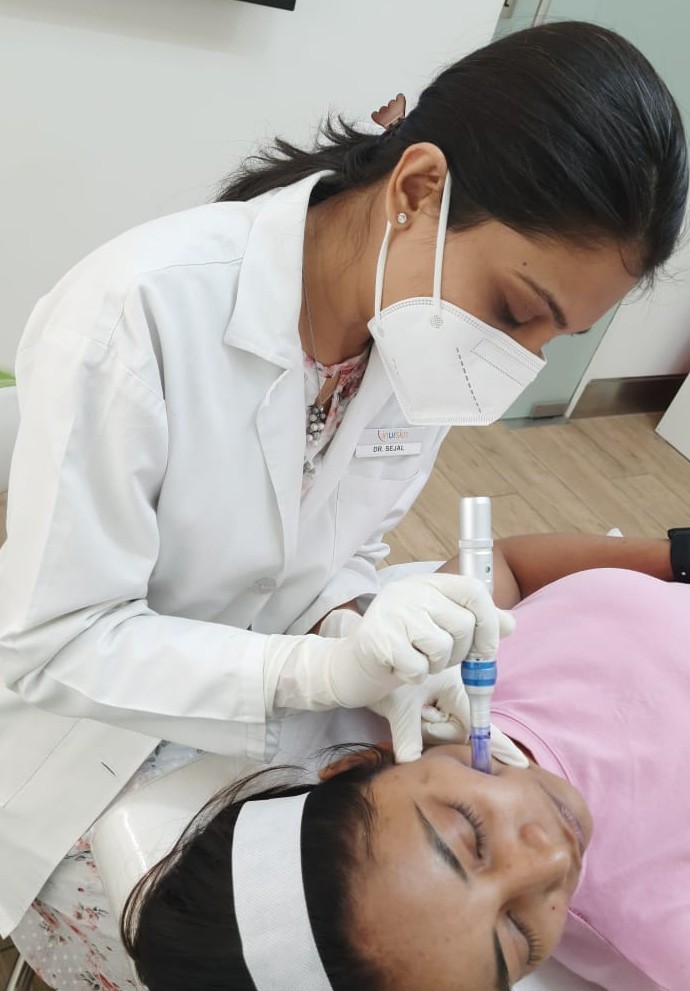
At InUrSkn, we believe that all patient care must be:
– Holistic
– Personalized
– Humane
– Minimal
Dr. Sejal and her team live by the philosophy of never prescribing medications or procedures that may not be required. When addressing a concern, Dr. Sejal ensures that a detailed history and context are thoroughly understood. Medical tests are prescribed by Dr. Sejal only when she believes there is more to the concern that needs to be addressed, ensuring the patient truly benefits.
Multiple spacious procedure rooms
Full-fledged operation theatre
In-house laboratory
Latest technology
100+ Skin, Hair & Body Procedures offered
Frequent disinfection of all clinic spaces with UVC light and WHO-approved chemicals
Large waiting and treatment areas to ensure social distancing
Regular health checks for all patients and staff
Safer than salons, chain-clinics & hospitals
PPEs for patients and staff
Personal attention from Dr. Sejal Saheta (MD, DNB) - with 15+ years of experience
CIDESCO-certified aestheticians with minimum 3 years work experience
500+ Positive Reviews on Practo and Google
5000+ Patients treated last year alone
8000+ Procedures completed
| Prices | ||
|---|---|---|
| Procedure | ||
| In Clinic Consultation with Dr. Sejal | ||
| In Clinic Consultation with Dr. Sejal | ₹1100 | |
| Online Consultation with Dr. Sejal | ||
| Online Consultation with Dr. Sejal | ₹900 | |
Pricing (Inclusive of taxes)


Yes, Dr. Sejal does prioritize very small babies and older patients, however it is better to indicate the same when making an appointment.
Yes, although the clinic is on the 7th floor, the entire path is wheelchair accessible. In case you are unable to bring your wheelchair, InUrSkn staff will be happy to help older patients with a wheelchair right from the lobby to the clinic.
We are a dermatology practice and do not deal with airborne diseases. We also follow safety protocols as detailed in the clinic section of the website towards disinfection and cleaning at the clinic.
Yes, however appointment for the same needs to be made in advance. In case of any emergency it is better to approach a hospital which offers immediate relief to the patient.

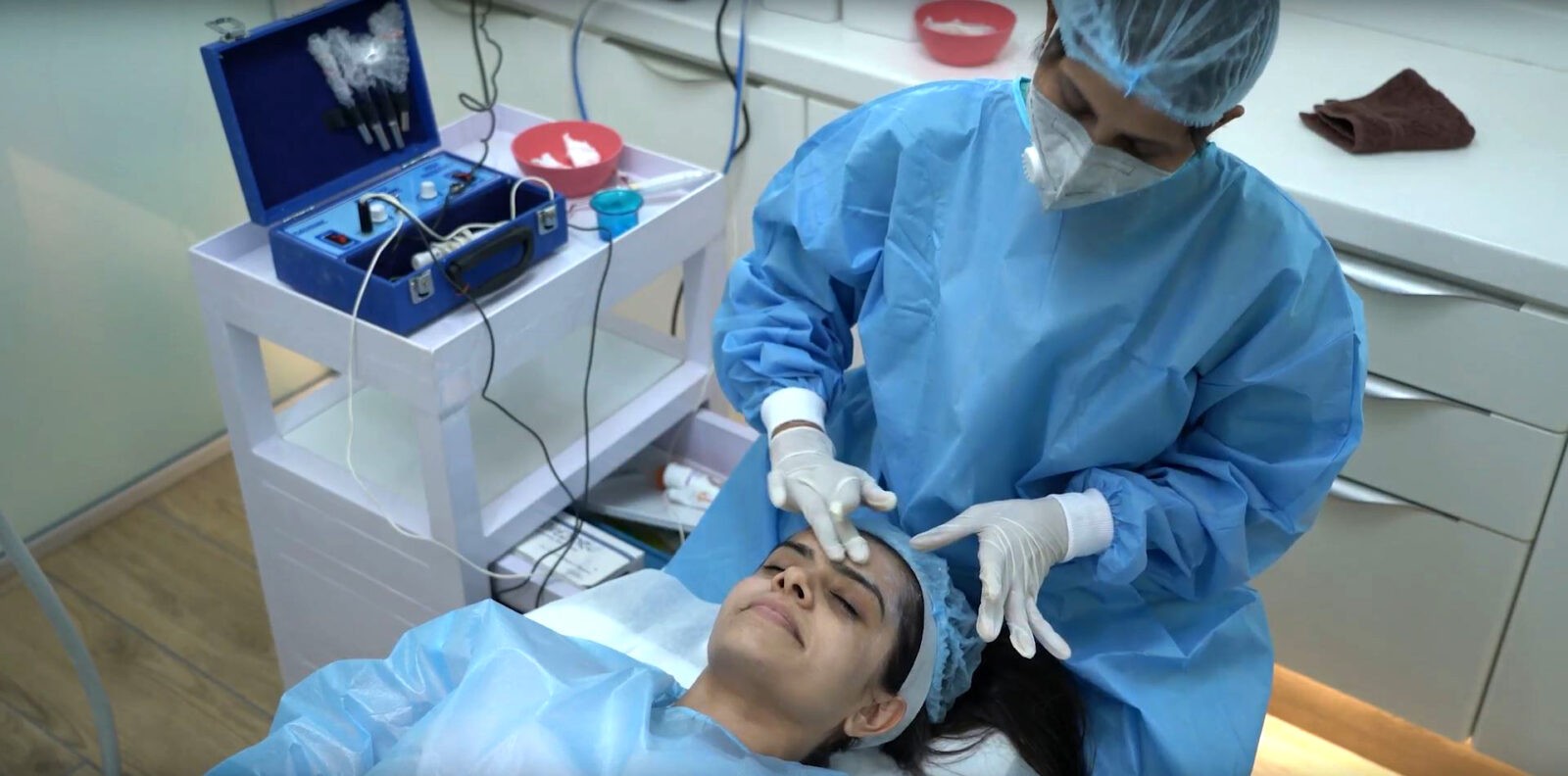
Ready to book an appointment?
BOOK
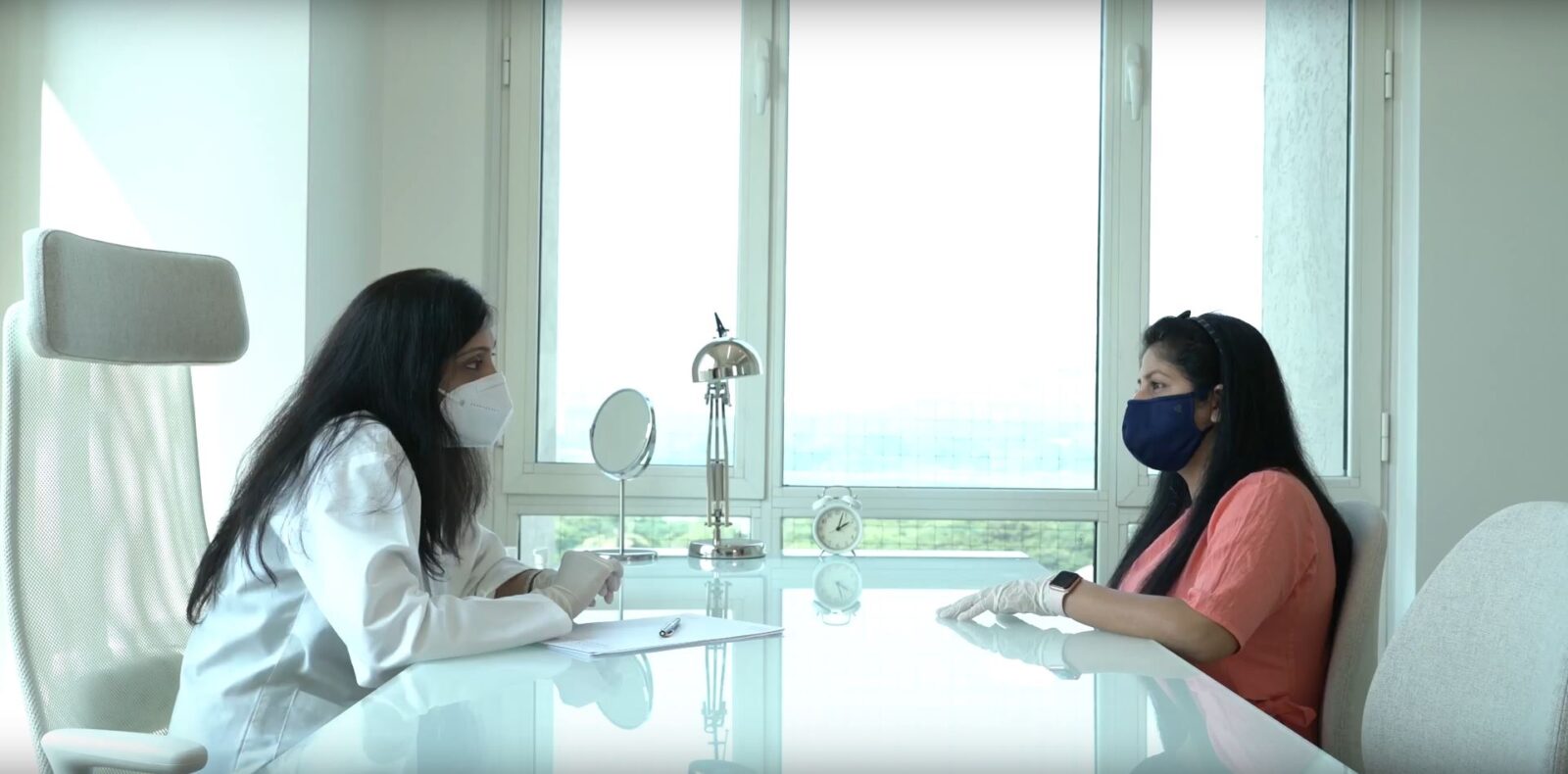
Want to talk about your needs ?
MAKE AN enquiry
